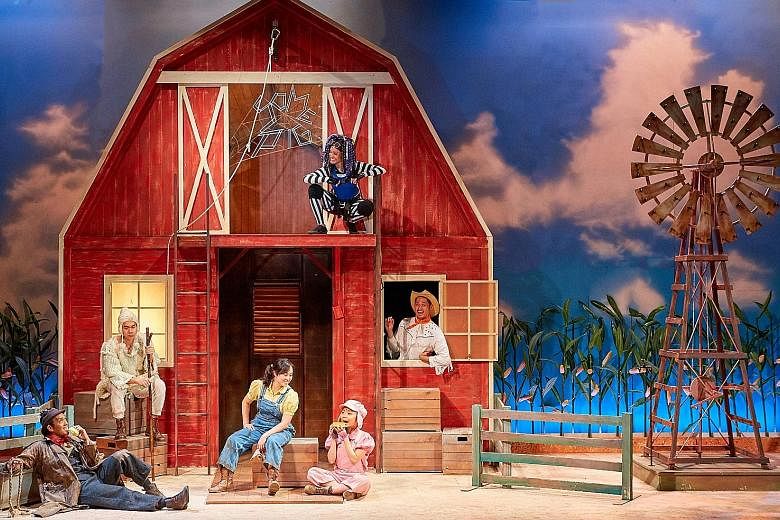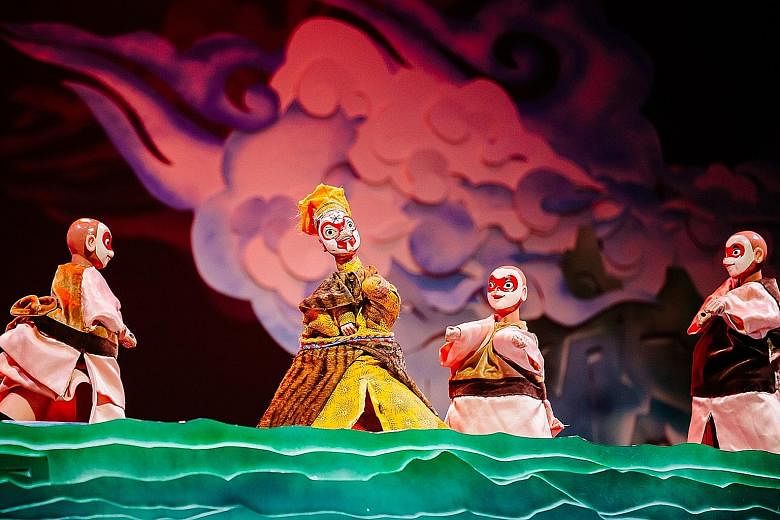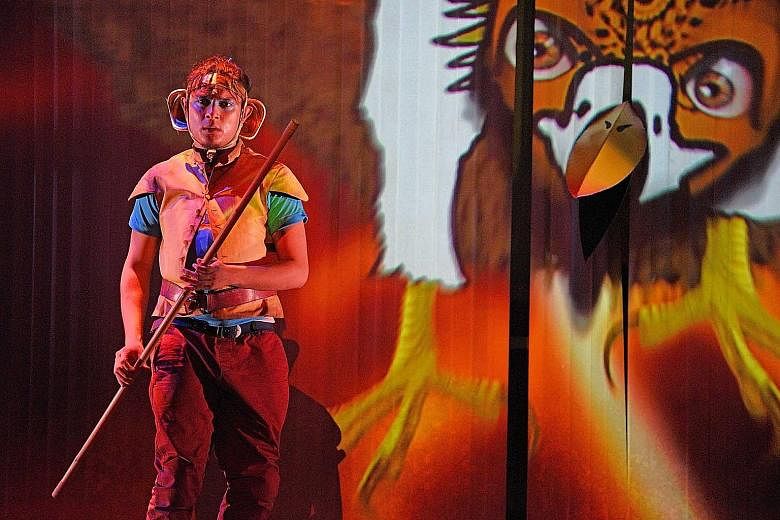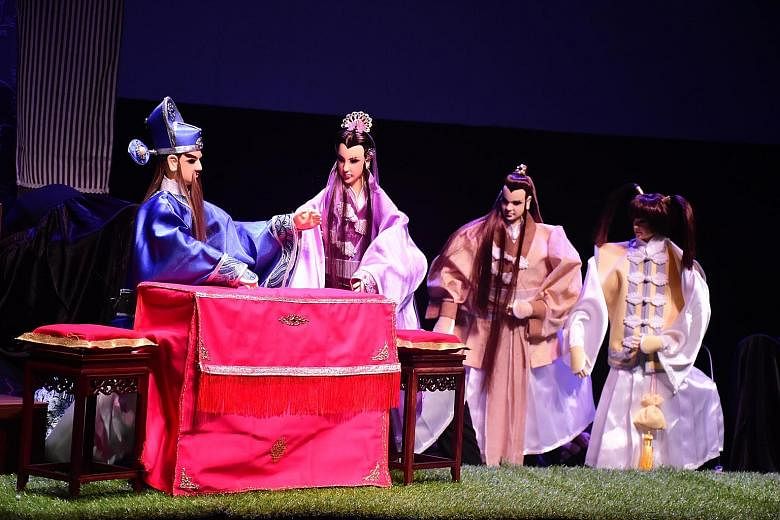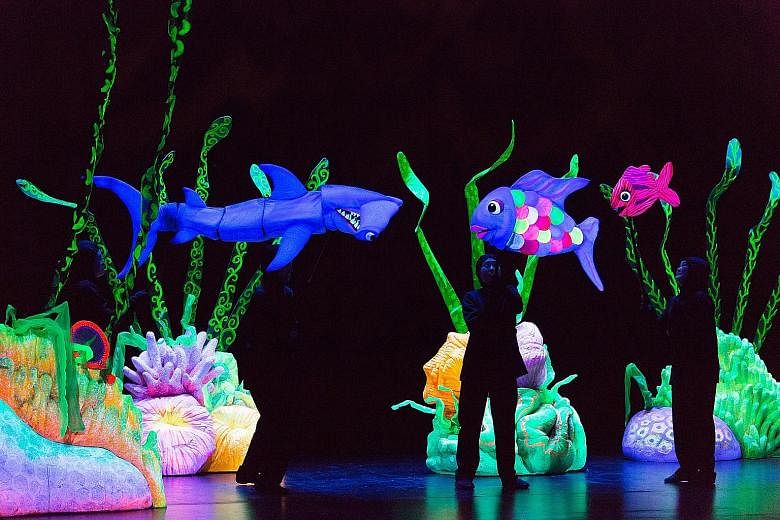Animal characters, brightly coloured costumes and high-energy scenes are a mainstay for theatre productions aimed at the young, but companies here are going to greater lengths to engage young audiences.
This can be seen in the five productions that are vying for the Best Production For The Young award at the M1-The Straits Times Life Theatre Awards 2017.
From puppetry to the innovative use of technology and intelligent forms of staging and costuming, which harnessed the imagination, these productions pulled out all the stops.
Productions eligible for the award must be created for audiences age 12 and younger and staged by Singapore companies. There were 24 eligible productions for this year's awards.

This is the second year that the award, organised in partnership with the National Arts Council, will be given out.
Three of the nominees featured stories with Asian themes: The Finger Players with its traditional hand puppetry show, Journey To The West: Treasures From The Dragon Palace; Paper Monkey Theatre with its production, The Magic Lantern; and Hanuman - The Superhero Monkey by Singapore Repertory Theatre's The Little Company.
The Little Company was also nominated for its production of Charlotte's Web, based on the E.B. White book.
And rounding off the nominees is I Theatre with its black-light theatre show, Rainbow Fish, based on the book by Marcus Pfister.
"It's an exciting time for children's theatre in Singapore," says Mr Kenneth Kwok, the National Arts Council's director of arts and youth, strategic planning and capability development.
"This year's shortlisted productions showcase the creativity of our Singapore artists in refreshing well-loved stories for another generation of young theatregoers."
•For more Life Theatre Awards stories, go to http://str.sg/4sDs.
Charlotte's Web by Singapore Repertory Theatre's The Little Company
When staging a play with a pig and a spider as characters, one might imagine the actors wearing a snout or having eight legs .
But The Little Company's production of Charlotte's Web, a tale about the friendship between a spider and a pig, went a different way.
Actress Ann Lek, playing Wilbur the pig, wore an all-pink ensemble with a woolly pink hat that had flaps covering her ears. And instead of giving actress Sharda Harrison, who played main character Charlotte the spider, four extra legs, directors Kate Golledge and Ellis Kerkhoven had her in a harness, with her feet almost never touching the ground.
The vibrant costumes and set were designed by British production designer James Button.
Ms Charlotte Nors, executive director of Singapore Repertory Theatre, says: "There were fewer animal costumes. Kids are smart - as long as you make it somewhat logical and creative, they won't be in doubt of the characters."
This was the first time The Little Company staged Charlotte's Web, which is based on the children's book by E.B. White.
Judges of the Best Production For The Young award praised the six- member cast for their versatility and sincerity in playing multiple characters from the book.
Judge and The Straits Times correspondent Venessa Lee says: "Some of the actors played multiple roles effectively, with deft costume changes and changes in mannerisms and bearing. I didn't immediately realise some of them were playing different roles."
Journey To The West: Treasures From The Dragon Palace by The Finger Players
In presenting Journey To The West: Treasures From The Dragon Palace last year, The Finger Players came full circle.
Journey To The West was the company's first production in 1996, when it was still the children's division within The Theatre Practice.
The Finger Players, a company specialising in both Eastern and Western puppetry styles, officially became a company in 1999.
The new production, staged two decades later as part of the Esplanade's Feed Your Imagination series, was a modern retelling of the classic tale.
"It's special when we are able to revisit our roots, " says Chong Tze Chien, company director of The Finger Players.
"We're a contemporary theatre company specialising in puppetry, so in revisiting our first piece of work, we wanted to update it for modern audiences."
While the 1996 version was staged in a temple and showcased puppets within a frame, the modern version featured panoramic staging, designed by Wong Chee Wai. It showed the entire narrative and landscape at a glance.
The show, which was commissioned by the Esplanade, also addressed issues such as how one can be a responsible hero and what it takes to be one.
Another interesting point is that in the first version, a master puppeteer from China, Master Lee, played the lead role. This time, the master's son, who resides in Hong Kong, was the one who trained the Singapore puppeteers.
Award judge Venessa Lee describes the show as an "energetic, appealing production with a masterful use of puppets in portraying elements of Chinese mythology, martial arts and acrobatics".
Hanuman - The Superhero Monkey by Singapore Repertory Theatre's The Little Company
It was apt that the Singapore Repertory Theatre's The Little Company presented the story Hanuman - The Superhero Monkey, last year. After all, it was the lunar Year of the Monkey.
Hanuman, a figure from the Ramayana epic, was presented as a superhero with four fellow monkey friends in The Little Company's adaptation.
Independent theatre director and drama educator Jeffrey Tan, who is among the judges of the award, calls the production "one of the most beautifully designed" plays, with "innovative use of projections".
The show was created in collaboration with British theatre company, Imitating The Dog, which is known for incorporating multimedia in its shows.
Two of the company's artistic directors, Peter Brooks and Andrew Quick, also wrote and directed the play.
The projections were combined with the use of screens with slits in them, which allowed some projections to appear 3D. For example, an eagle projected onto the screen had part of its beak poking through the screen.
Some characters, such as the villain Ravana, were shown only as projections, which the actors interacted with.
The blending of 2D and 3D gave the production the effect of a comic book come to life.
Ms Charlotte Nors, executive director of Singapore Repertory Theatre, says: "Kids are on iPads all the time. Our production offered a different kind of expression that was a mix between a cartoon and a real act."
The Magic Lantern by Paper Monkey Theatre
The Magic Lantern is based on a classic Chinese love story of a heavenly goddess who falls in love with a mortal.
Paper Monkey Theatre's adaptation of it integrated a modern-day storyline - a secondary narrative about a boy who is upset with his mother and dreams he is the son of the goddess in the folk tale. The show, commissioned by the Esplanade for Moonfest - A Mid-Autumn Celebration - used multiple techniques of puppetry to tell the different stories.
The classic story was told through the use of traditional hand puppets, which were small and easier to manoeuvre for fight scenes, and larger Taiwan-made puppets (above), which looked more majestic and were controlled by both hand and rod.
The larger puppets are known as "pili" or "thunderbolt" puppets, named after a glove puppetry show in Taiwan. The puppets, each costing $1,000 and up, were imported for the show.
In contrast, the modern-day storyline was told using shadow puppetry, executed using paper cut- outs and overhead projectors.
Benjamin Ho, artistic director of Paper Monkey Theatre, also collaborated with Singapore experimental music collective, SA, to "show children that Chinese music can be hip". The trio are known for combining traditional Chinese instruments, such as guzheng and dizi (flute), with modern techniques, such as live looping.
An award judge, Ms Peggy Ferroa, who is an independent artist educator and vice-president of the Singapore Drama Educators Association, says the many forms of puppetry "didn't look contrived".
She adds: "Everything served a purpose - to tell a story well with a lot of heart... I felt very humbled after watching it and felt I needed to connect more to family."
Rainbow Fish by I Theatre
I Theatre's staging of Rainbow Fish was done black-light theatre style - where fluorescent coloured props or costumes were set against a dark stage and UV light used to create a vibrant, contrasting effect.
The performers were dressed in black and carried or wore sea creature puppets on their bodies.
But it had not always been that way. The original script was written by artistic director Brian Seward in 2002.
In the early versions, the performers carried the bodies of the sea creatures on their shoulders and their faces, painted fluorescent, would be the faces of the fish.
"One of the performers went to the disco after a show and the traces of the fluorescent paint on her face glowed. We had to change the make-up after that," recalls Seward with a laugh.
The show, based on the children's storybook by Marcus Pfister, has been staged by I Theatre seven times. It has also toured India, Australia, the United States and the United Kingdom.
Award judge Jeffrey Tan calls the production "a classic retelling of a beautiful tale through music and puppets" and commends its "energetic actors".
There were nine in the cast, including puppeteers, who managed multiple characters.
A new character in the latest staging was a Japanese hammerhead shark that likes to eat sushi.
Seward says the show was "technically a tricky production to stage".
Four of the puppets had moving mouths, while some of them were more than 1m long, including a 5m- long octopus, which required at least four people to handle.
